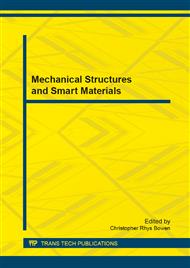p.75
p.80
p.84
p.90
p.94
p.98
p.102
p.106
p.110
Research of Calibration Curves NMR Relaxation Times of Nanoparticles Gadolinium Oxide
Abstract:
In this paper, a method of assay based on NMR (Nuclear Magnetic Resonance) measurements was developed. A protocol for the dissolution of gadolinium oxide cores and calibration curves were established for Nanoparticles gadolinium oxide. After optimization this method was used for several applications such as checking the concentration in colloids after dialysis or controlling the concentration and the form (oxides or free ions) of lanthanides after in vivo injection. The Experiments showed the samples did not present any suspension or deposit after the dissolution treatment, The concentrations calculated from relaxation measurements are very close to the concentrations measured . According to measure relaxation times T1 and T2, we can approximately determinate the gadolinium concentration. .
Info:
Periodical:
Pages:
94-97
Citation:
Online since:
January 2014
Authors:
Price:
Сopyright:
© 2014 Trans Tech Publications Ltd. All Rights Reserved
Share:
Citation:


